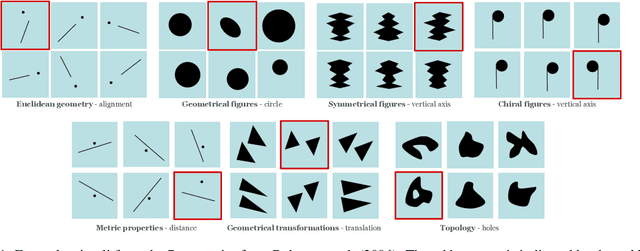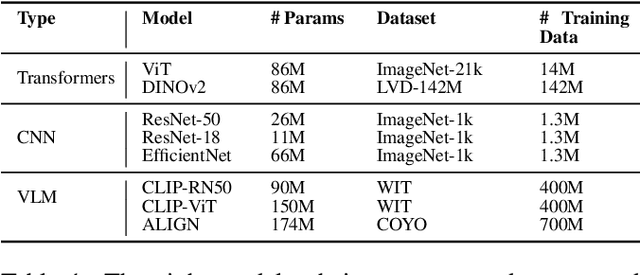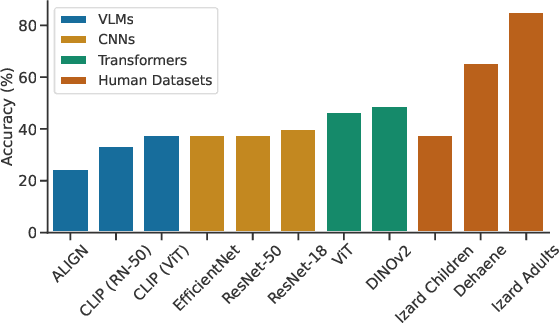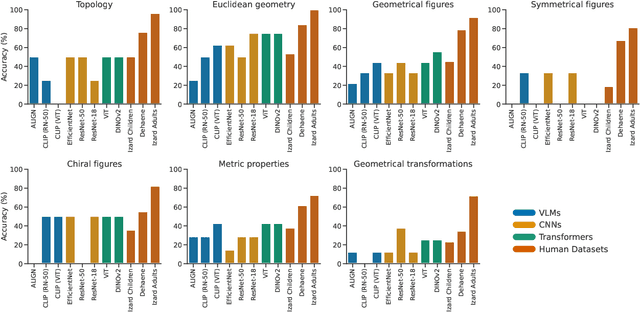Sashank Varma
The World According to LLMs: How Geographic Origin Influences LLMs' Entity Deduction Capabilities
Aug 07, 2025Abstract:Large Language Models (LLMs) have been extensively tuned to mitigate explicit biases, yet they often exhibit subtle implicit biases rooted in their pre-training data. Rather than directly probing LLMs with human-crafted questions that may trigger guardrails, we propose studying how models behave when they proactively ask questions themselves. The 20 Questions game, a multi-turn deduction task, serves as an ideal testbed for this purpose. We systematically evaluate geographic performance disparities in entity deduction using a new dataset, Geo20Q+, consisting of both notable people and culturally significant objects (e.g., foods, landmarks, animals) from diverse regions. We test popular LLMs across two gameplay configurations (canonical 20-question and unlimited turns) and in seven languages (English, Hindi, Mandarin, Japanese, French, Spanish, and Turkish). Our results reveal geographic disparities: LLMs are substantially more successful at deducing entities from the Global North than the Global South, and the Global West than the Global East. While Wikipedia pageviews and pre-training corpus frequency correlate mildly with performance, they fail to fully explain these disparities. Notably, the language in which the game is played has minimal impact on performance gaps. These findings demonstrate the value of creative, free-form evaluation frameworks for uncovering subtle biases in LLMs that remain hidden in standard prompting setups. By analyzing how models initiate and pursue reasoning goals over multiple turns, we find geographic and cultural disparities embedded in their reasoning processes. We release the dataset (Geo20Q+) and code at https://sites.google.com/view/llmbias20q/home.
A Neural Network Model of Complementary Learning Systems: Pattern Separation and Completion for Continual Learning
Jul 15, 2025Abstract:Learning new information without forgetting prior knowledge is central to human intelligence. In contrast, neural network models suffer from catastrophic forgetting: a significant degradation in performance on previously learned tasks when acquiring new information. The Complementary Learning Systems (CLS) theory offers an explanation for this human ability, proposing that the brain has distinct systems for pattern separation (encoding distinct memories) and pattern completion (retrieving complete memories from partial cues). To capture these complementary functions, we leverage the representational generalization capabilities of variational autoencoders (VAEs) and the robust memory storage properties of Modern Hopfield networks (MHNs), combining them into a neurally plausible continual learning model. We evaluate this model on the Split-MNIST task, a popular continual learning benchmark, and achieve close to state-of-the-art accuracy (~90%), substantially reducing forgetting. Representational analyses empirically confirm the functional dissociation: the VAE underwrites pattern completion, while the MHN drives pattern separation. By capturing pattern separation and completion in scalable architectures, our work provides a functional template for modeling memory consolidation, generalization, and continual learning in both biological and artificial systems.
Computer Vision Models Show Human-Like Sensitivity to Geometric and Topological Concepts
May 19, 2025



Abstract:With the rapid improvement of machine learning (ML) models, cognitive scientists are increasingly asking about their alignment with how humans think. Here, we ask this question for computer vision models and human sensitivity to geometric and topological (GT) concepts. Under the core knowledge account, these concepts are innate and supported by dedicated neural circuitry. In this work, we investigate an alternative explanation, that GT concepts are learned ``for free'' through everyday interaction with the environment. We do so using computer visions models, which are trained on large image datasets. We build on prior studies to investigate the overall performance and human alignment of three classes of models -- convolutional neural networks (CNNs), transformer-based models, and vision-language models -- on an odd-one-out task testing 43 GT concepts spanning seven classes. Transformer-based models achieve the highest overall accuracy, surpassing that of young children. They also show strong alignment with children's performance, finding the same classes of concepts easy vs. difficult. By contrast, vision-language models underperform their vision-only counterparts and deviate further from human profiles, indicating that na\"ive multimodality might compromise abstract geometric sensitivity. These findings support the use of computer vision models to evaluate the sufficiency of the learning account for explaining human sensitivity to GT concepts, while also suggesting that integrating linguistic and visual representations might have unpredicted deleterious consequences.
* 10 pages, 4 figures, CosSci 2025
Understanding Graphical Perception in Data Visualization through Zero-shot Prompting of Vision-Language Models
Oct 31, 2024Abstract:Vision Language Models (VLMs) have been successful at many chart comprehension tasks that require attending to both the images of charts and their accompanying textual descriptions. However, it is not well established how VLM performance profiles map to human-like behaviors. If VLMs can be shown to have human-like chart comprehension abilities, they can then be applied to a broader range of tasks, such as designing and evaluating visualizations for human readers. This paper lays the foundations for such applications by evaluating the accuracy of zero-shot prompting of VLMs on graphical perception tasks with established human performance profiles. Our findings reveal that VLMs perform similarly to humans under specific task and style combinations, suggesting that they have the potential to be used for modeling human performance. Additionally, variations to the input stimuli show that VLM accuracy is sensitive to stylistic changes such as fill color and chart contiguity, even when the underlying data and data mappings are the same.
Development of Cognitive Intelligence in Pre-trained Language Models
Jul 01, 2024Abstract:Recent studies show evidence for emergent cognitive abilities in Large Pre-trained Language Models (PLMs). The increasing cognitive alignment of these models has made them candidates for cognitive science theories. Prior research into the emergent cognitive abilities of PLMs has largely been path-independent to model training, i.e., has focused on the final model weights and not the intermediate steps. However, building plausible models of human cognition using PLMs would benefit from considering the developmental alignment of their performance during training to the trajectories of children's thinking. Guided by psychometric tests of human intelligence, we choose four sets of tasks to investigate the alignment of ten popular families of PLMs and evaluate their available intermediate and final training steps. These tasks are Numerical ability, Linguistic abilities, Conceptual understanding, and Fluid reasoning. We find a striking regularity: regardless of model size, the developmental trajectories of PLMs consistently exhibit a window of maximal alignment to human cognitive development. Before that window, training appears to endow "blank slate" models with the requisite structure to be poised to rapidly learn from experience. After that window, training appears to serve the engineering goal of reducing loss but not the scientific goal of increasing alignment with human cognition.
Incremental Comprehension of Garden-Path Sentences by Large Language Models: Semantic Interpretation, Syntactic Re-Analysis, and Attention
May 25, 2024



Abstract:When reading temporarily ambiguous garden-path sentences, misinterpretations sometimes linger past the point of disambiguation. This phenomenon has traditionally been studied in psycholinguistic experiments using online measures such as reading times and offline measures such as comprehension questions. Here, we investigate the processing of garden-path sentences and the fate of lingering misinterpretations using four large language models (LLMs): GPT-2, LLaMA-2, Flan-T5, and RoBERTa. The overall goal is to evaluate whether humans and LLMs are aligned in their processing of garden-path sentences and in the lingering misinterpretations past the point of disambiguation, especially when extra-syntactic information (e.g., a comma delimiting a clause boundary) is present to guide processing. We address this goal using 24 garden-path sentences that have optional transitive and reflexive verbs leading to temporary ambiguities. For each sentence, there are a pair of comprehension questions corresponding to the misinterpretation and the correct interpretation. In three experiments, we (1) measure the dynamic semantic interpretations of LLMs using the question-answering task; (2) track whether these models shift their implicit parse tree at the point of disambiguation (or by the end of the sentence); and (3) visualize the model components that attend to disambiguating information when processing the question probes. These experiments show promising alignment between humans and LLMs in the processing of garden-path sentences, especially when extra-syntactic information is available to guide processing.
How Well Do Deep Learning Models Capture Human Concepts? The Case of the Typicality Effect
May 25, 2024Abstract:How well do representations learned by ML models align with those of humans? Here, we consider concept representations learned by deep learning models and evaluate whether they show a fundamental behavioral signature of human concepts, the typicality effect. This is the finding that people judge some instances (e.g., robin) of a category (e.g., Bird) to be more typical than others (e.g., penguin). Recent research looking for human-like typicality effects in language and vision models has focused on models of a single modality, tested only a small number of concepts, and found only modest correlations with human typicality ratings. The current study expands this behavioral evaluation of models by considering a broader range of language (N = 8) and vision (N = 10) model architectures. It also evaluates whether the combined typicality predictions of vision + language model pairs, as well as a multimodal CLIP-based model, are better aligned with human typicality judgments than those of models of either modality alone. Finally, it evaluates the models across a broader range of concepts (N = 27) than prior studies. There were three important findings. First, language models better align with human typicality judgments than vision models. Second, combined language and vision models (e.g., AlexNet + MiniLM) better predict the human typicality data than the best-performing language model (i.e., MiniLM) or vision model (i.e., ViT-Huge) alone. Third, multimodal models (i.e., CLIP ViT) show promise for explaining human typicality judgments. These results advance the state-of-the-art in aligning the conceptual representations of ML models and humans. A methodological contribution is the creation of a new image set for testing the conceptual alignment of vision models.
Towards a Path Dependent Account of Category Fluency
May 14, 2024Abstract:Category fluency is a widely studied cognitive phenomenon, yet two conflicting accounts have been proposed as the underlying retrieval mechanism -- an optimal foraging process deliberately searching through memory (Hills et al., 2012) and a random walk sampling from a semantic network (Abbott et al., 2015). Evidence for both accounts has centered around predicting human patch switches, where both existing models of category fluency produce paradoxically identical results. We begin by peeling back the assumptions made by existing models, namely that each named example only depends on the previous example, by (i) adding an additional bias to model the category transition probability directly and (ii) relying on a large language model to predict based on the entire existing sequence. Then, we present evidence towards resolving the disagreement between each account of foraging by reformulating models as sequence generators. To evaluate, we compare generated category fluency runs to a bank of human-written sequences by proposing a metric based on n-gram overlap. We find category switch predictors do not necessarily produce human-like sequences, in fact the additional biases used by the Hills et al. (2012) model are required to improve generation quality, which are later improved by our category modification. Even generating exclusively with an LLM requires an additional global cue to trigger the patch switching behavior during production. Further tests on only the search process on top of the semantic network highlight the importance of deterministic search to replicate human behavior.
Cobweb: An Incremental and Hierarchical Model of Human-Like Category Learning
Mar 06, 2024Abstract:Cobweb, a human like category learning system, differs from other incremental categorization models in constructing hierarchically organized cognitive tree-like structures using the category utility measure. Prior studies have shown that Cobweb can capture psychological effects such as the basic level, typicality, and fan effects. However, a broader evaluation of Cobweb as a model of human categorization remains lacking. The current study addresses this gap. It establishes Cobweb's alignment with classical human category learning effects. It also explores Cobweb's flexibility to exhibit both exemplar and prototype like learning within a single model. These findings set the stage for future research on Cobweb as a comprehensive model of human category learning.
Catastrophic Interference is Mitigated in Naturalistic Power-Law Learning Environments
Jan 22, 2024Abstract:Neural networks often suffer from catastrophic interference (CI): performance on previously learned tasks drops off significantly when learning a new task. This contrasts strongly with humans, who can sequentially learn new tasks without appreciably forgetting previous tasks. Prior work has explored various techniques for mitigating CI such as regularization, rehearsal, generative replay, and distillation methods. The current work takes a different approach, one guided by cognitive science research showing that in naturalistic environments, the probability of encountering a task decreases as a power-law of the time since it was last performed. We argue that a realistic evaluation of techniques for the mitigation of CI should be performed in simulated naturalistic learning environments. Thus, we evaluate the extent of mitigation of CI when training simple rehearsal-based methods in power-law environments similar to the ones humans face. Our work explores this novel rehearsal-based approach for a domain-incremental task: learning permutations in the MNIST task. We compare our rehearsal environment with other baselines to show its efficacy in promoting continual learning. Additionally, we investigate whether this environment shows forward facilitation, i.e., faster learning of later tasks. Next, we explore the robustness of our learning environment to the number of tasks, model size, and amount of data rehearsed after each task. Notably, our results show that the performance is comparable or superior to that of models trained using popular regularization methods and also to rehearsals in non-power-law environments. The benefits of this training paradigm include simplicity and the lack of a need for extra neural circuitry. In addition, because our method is orthogonal to other methods, future research can combine training in power-law environments with other continual learning mechanisms.
 Add to Chrome
Add to Chrome Add to Firefox
Add to Firefox Add to Edge
Add to Edge